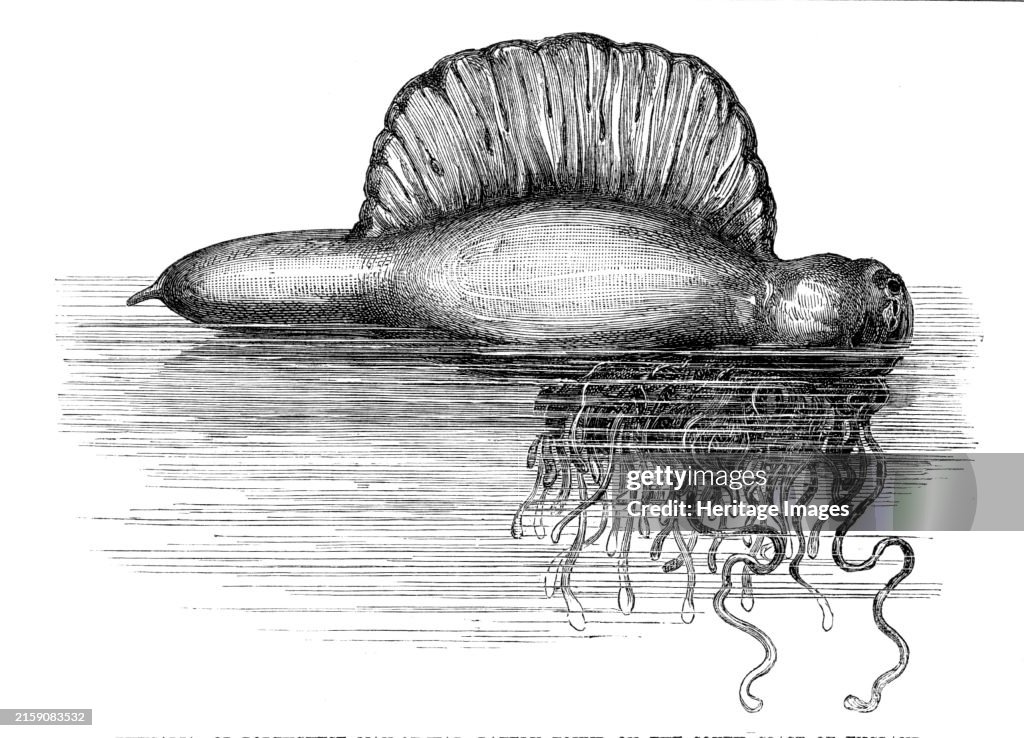Physalia
Physalia, or Portuguese Man-of-War, lately found on the south coast of England, 1869. Illustration of '...a physalia, one of the so-called unexpected visitors whose recent advent to our shores has been hailed as affording conclusive evidence of the increasing energy of the much-vexed Gulf Stream...[however] the circumstance of its appearing...in unusual numbers is, in all probability, due to the long-continued action of southerly and south-westerly winds...The body consists of a transparent spindle-shaped air-chamber possessing singular strength; its upper convex surface is traversed longitudinally by a crescent-shaped crest; whilst dependent from the under portion of the air-vessel, which rests on the surface of the sea, are two sets of tentacles; one of these brings its food to the creature; the other would seem to provide it with means of attack and defence, being supplied with very powerful stinging organs, the effects of handling which are not likely to be forgotten by those who have once experienced them...the colouring of the physalia is singularly delicate and beautiful, the air-chamber presenting tints of the purest azure...the air-vessel...forms a conspicuous object when floating on the placid waters of the tropics'. From "Illustrated London News", 1869. Creator: Unknown. (Photo by The Print Collector/Heritage Images via Getty Images)

PURCHASE A LICENSE
How can I use this image?
€300.00
EUR
Getty ImagesPhysalia, News Photo Physalia Get premium, high resolution news photos at Getty ImagesProduct #:2159083532
Physalia Get premium, high resolution news photos at Getty ImagesProduct #:2159083532
 Physalia Get premium, high resolution news photos at Getty ImagesProduct #:2159083532
Physalia Get premium, high resolution news photos at Getty ImagesProduct #:2159083532€475€115
Getty Images
In stockPlease note: images depicting historical events may contain themes, or have descriptions, that do not reflect current understanding. They are provided in a historical context. .
DETAILS
Restrictions:
Contact your local office for all commercial or promotional uses.
Credit:
Editorial #:
2159083532
Collection:
Hulton Archive
Date created:
January 01, 1869
Upload date:
License type:
Release info:
Not released.��More information
Source:
Hulton Archive
Object name:
3021288
Max file size:
2564 x 1848 px (8.55 x 6.16 in) - 300 dpi - 2 MB
- 1869,
- 19th Century,
- 19th Century Style,
- Archival,
- Art,
- Black And White,
- Color Image,
- Danger,
- England,
- Engraving,
- Environment,
- Finding,
- Horizontal,
- Human Interest,
- Illustrated London News,
- Inflatable,
- Jellyfish,
- Newspaper,
- Photography,
- Poisonous,
- Portuguese Man O' War,
- Sea Life,
- Stinging,
- Tentacle,
- Text,
- UK,
- Unexpected,
- Weather,
- Wind,